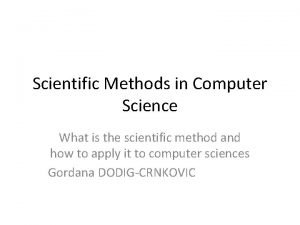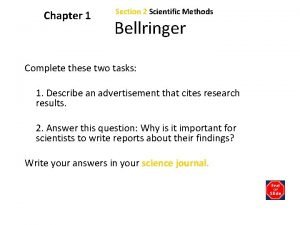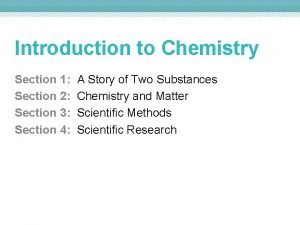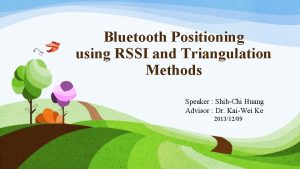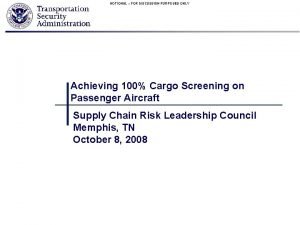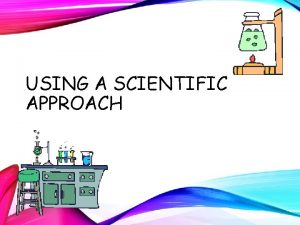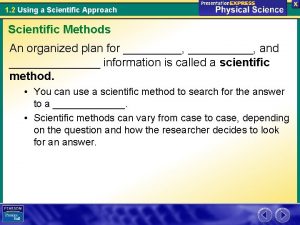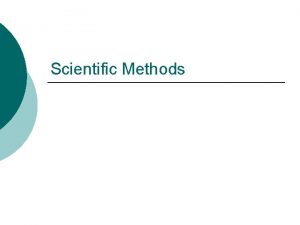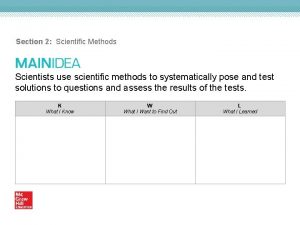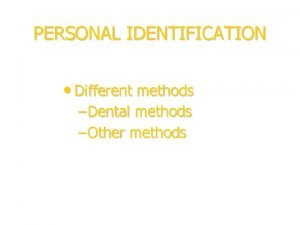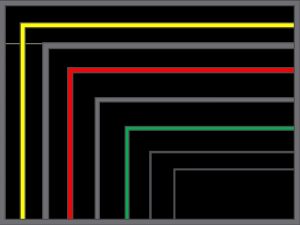1 2 Using a Scientific Approach Scientific Methods











- Slides: 11

1. 2 Using a Scientific Approach Scientific Methods An organized plan for gathering, organizing, and communicating information is called a scientific method. • Scientific methods can vary from case to case, depending on the question and how the researcher decides to look for an answer. • The goal of any scientific method is to solve a problem or to better understand an observed event.

1. 2 Using a Scientific Approach Scientific Methods Here is an example of a scientific method. Each step uses specific skills. The order of steps can vary. Sometimes you will use all of the steps and other times only some of them.

1. 2 Using a Scientific Approach Making Observations An observation is information that you obtain through your senses. Forming a Hypothesis A hypothesis is a proposed answer to a question. Testing a Hypothesis • The manipulated (independent) variable causes a change. • The responding (dependent) variable changes in response to the manipulated variable. • A controlled experiment is an experiment in which only one variable, the manipulated variable, is deliberately changed at a time.

1. 2 Using a Scientific Approach Scientific Methods Drawing Conclusions A conclusion describes how facts apply to a hypothesis. Developing a Theory A scientific theory is a well-tested explanation for a set of observations or experimental results. Scientific Law A scientific law is a statement that summarizes a pattern found in nature. The explanation of such a pattern is provided by a scientific theory.

1. 2 Using a Scientific Approach Scientific Models v. A model is a representation of an object or event. A street map is a model of a city. v. Scientific models make it easier to understand things that might be too difficult to observe directly. v. Models help you visualize things that are too small to see, such as atoms, or things that are very large, such as the solar system. v. An example of a mental, rather than physical, model might be that comets are like giant snowballs, primarily made of ice.

1. 2 Using a Scientific Approach Using Scientific Notation Why is scientific notation useful? Scientists often work with very large or very small numbers. Astronomers estimate there are 200, 000, 000 stars in our galaxy.

1. 2 Using a Scientific Approach Using Scientific Notation Scientific notation is a way of expressing a value as the product of a number between 1 and 10 and a power of 10. For example, the speed of light is about 300, 000 meters per second. In scientific notation, that speed is 3. 0 × 108 m/s. The exponent, 8, tells you that the decimal point is really 8 places to the right of the 3.

1. 2 Using a Scientific Approach Using Scientific Notation For numbers less than 1 that are written in scientific notation, the exponent is negative. For example, an average snail’s pace is 0. 00086 meters per second. In scientific notation, that speed is 8. 6 × 10 -4 m/s. The negative exponent tells you how many decimals places there are to the left of the 8. 6.

1. 2 Using a Scientific Approach Using Scientific Notation v. To multiply numbers written in scientific notation: vmultiply the numbers that appear before the multiplication signs vadd the exponents This is about the distance between the sun and Earth.

1. 2 Using a Scientific Approach Using Scientific Notation v. To divide numbers written in scientific notation: vdivide the numbers that appear before the multiplication signs vsubtract the exponents The following example demonstrates how to calculate the time it takes light from the sun to reach Earth.

1. 2 Using a Scientific Approach Using Scientific Notation A rectangular parking lot has a length of 1. 1 × 103 meters and a width of 2. 4 × 103 meters. Q: What is the area of the parking lot? A: 2. 64 × 106
 Indirect methods of contoring uses how many methods
Indirect methods of contoring uses how many methods Scientific methods in computer science
Scientific methods in computer science Chapter 1 section 2 scientific methods answer key
Chapter 1 section 2 scientific methods answer key Introduction to chemistry section 3 scientific methods
Introduction to chemistry section 3 scientific methods Using risk to balance agile and plan driven methods
Using risk to balance agile and plan driven methods Bluetooth positioning using rssi and triangulation methods
Bluetooth positioning using rssi and triangulation methods The iac must ensure custody of air cargo using what methods
The iac must ensure custody of air cargo using what methods Virtual circuit network uses
Virtual circuit network uses Theoretical models of counseling
Theoretical models of counseling Shower approach in international marketing
Shower approach in international marketing Multiple approach-avoidance conflict
Multiple approach-avoidance conflict Cognitive approach vs behavioral approach
Cognitive approach vs behavioral approach

